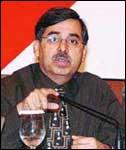A series of measures linked to curbing credit growth and lowering short-term interest rates twice this year, have pegged inflation to 4.27 per cent for the week ending July 4 from a two-year high of 6.73 per cent in January-end. Currently, India's inflation is within the medium-term range set by the RBI.
A variety of factors are, however, keeping the rupee firm against the dollar, which has risen by nearly 10 per cent between January-July this year. The rupee stands at a near-decade high of 40.3 against the dollar, from 44.2 when the year began.
Rupee appreciation has been the sharpest in three decades in the April-June quarter this year. And analysts expect the rupee to gain further.
The impact of a rupee rise
As the rupee rises against the dollar (or conversely the dollar weakens) Indian exports firms earn less and thus begin to lose their competitive edge -- whether it be textile, jewellery, software, drugs or automobiles.
India's 'big four' in the software pack -- Infosys], TCS , Wipro and Satyam have already seen their net income in the first quarter ending June, fall due to the sharp rupee rise. This is because India's software companies bill several clients in dollar terms.
A weak dollar thus hits currency-linked earnings.
The impact is seen through:
Lower exports, as exporters are unable to maintain necessary profit margins if their dollar-linked earnings fall. Analysts now predict that India's export target of $160 billion may not be met. A more 'realistic' export target for this year has been pegged at $135-140 billion.
If the rupee continues to gain against the dollar, India's competitive strength in world trade (which is already negligible) will weaken. This, in turn, shrinks new job avenues.
Exporters are keener to sell their product/services locally, if possible. This would increase local supplies and lower prices and inflation.
Export lobby groups and trade analysts are now urging the government to act to curb the rupee's rise. The equation is simple. In a competitive business environment where operating margins will determine survival, export houses are in a fix.
Jobs may be lost
However, on the other hand, if the rupee keeps strengthening, a lot many people may actually lose jobs. Exporters are also considering layoffs, which may eventually affect 275,000 jobs by the year-end.
Yet another fallout of the rupee rise is the proposal by the IT and BPO companies in India which plan to increase the working hours of their employees and doing away with a 5-day week and making them work on Saturdays too.
According to a study by the Union commerce ministry, the worst hit sectors are infotech, textile, leather, handicrafts, marine products, engineering, sports goods, toys and agri products.
How will the Rupee surge impact you?
With factors suggesting that the rupee could rise, we could see a scenario of an increasing percentage of goods and services being offered locally, which would lead to lower prices and hence curb inflation further.
Industries, where domestic prices are linked to the cost of imported raw material -- like metals, have and will lead to further lowering of input cost of imported aluminium and copper. A reduction in the domestic prices is expected. Obviously, importing price-sensitive electronics and gadgets would also be cheaper, as would other retail items.
An appreciating rupee shows the strength of the economy, which can be seen when one travels overseas, if you try to convert what the dollar is worth. So maybe you should plan your overseas trip now, if you have enough disposable income.
You obviously have concerns if you are an exporter or work in an export-house. Another groups of people who may not be happy to see the rupee rising, would be those who hold dollar-denominated accounts.







